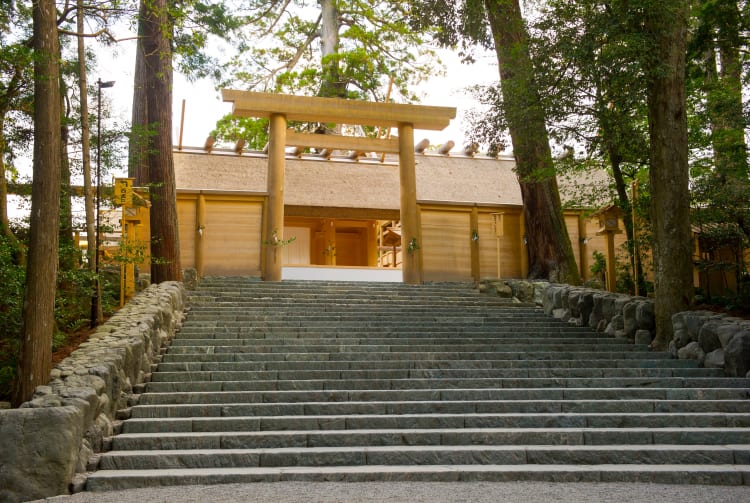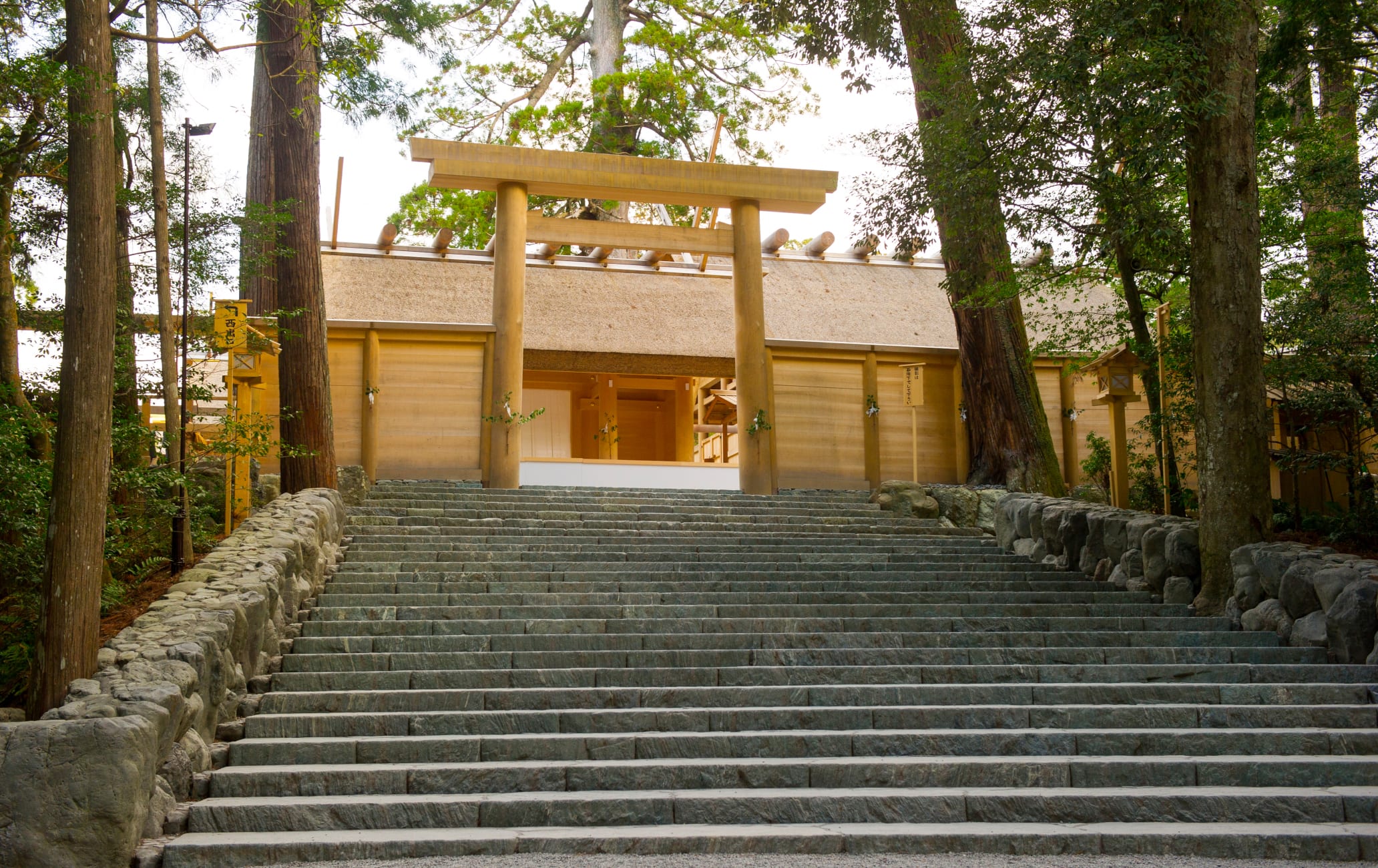Der heiligste Shinto-Schrein Japans
Kein Ort ist den Japanern heiliger als der Ise-jingu-Naiku. Ein Besuch bietet die besondere Möglichkeit, mit dem Herzen und der Seele der japanischen Bevölkerung in Berührung zu kommen.
Nicht verpassen
- Das sakralste Heiligtum der Shinto-Religion erkunden
- Einzigartige Geschenke und kulinarische Köstlichkeiten aus dem nahegelegenen Oharaimachi

Anfahrt
Von Geku im Zentrum von Ise bringt Sie ein Bus in 10 bis 15 Minuten zum Naiku.
Wenn Sie von anderen Ausgangsorten mit dem Zug anreisen, sind Sie am Bahnhof Isuzugawa näher am Ziel. Busse fahren häufig vom Bahnhof ab und benötigen 6 Minuten in eine Richtung.
Der Bahnhof Isuzugawa ist von den großen Städten in der Nähe an der Kintetsu Line erreichbar: von Nagoya in rund 90 Minuten, von Osaka-Namba in etwa 1 Stunde und 50 Minuten und von Kyoto in circa 2 Stunden und 30 Minuten.
Die Bedeutung von Ise-jingu
Naiku ist das wichtigste Bauwerk innerhalb des Ise-jingu-Schreinkomplexes. Die moderne Forschung datiert Naiku auf das 4. Jahrhundert zurück, einige Bauwerke wurden vermutlich schon ein Jahrhundert vorher errichtet.
Die Bedeutsamkeit Naikus basiert auf der Verehrung Amaterasu Omikamis und ihrer Bedeutung für den mythischen Ursprung Japans. Als Gottheit, die mit der Sonne verglichen wird, ist sie die höchste Gottheit der Shinto-Religion.
Die japanischen Kaiser, darunter auch der derzeitige Inhaber des Chrysanthemum-Throns, sind ihre direkten Nachkommen. Die heilige Priesterin des Ise-jingu muss mit dem kaiserlichen Haushalt in Verbindung stehen und der Kaiser selbst besucht den Schrein zu besonderen Anlässen, die von großer Bedeutung für den kaiserlichen Haushalt und die Nation sind.
Ein heiliger Spiegel, Yata-no-kagami, eine der drei kaiserlichen Regalien, die zur Nachfolge auf den Thron unabdingbar sind, wird als Symbol von Amaterasu Omikami im Hauptheiligtum von Naiku aufbewahrt. Der Shinto-Legende zufolge wurde dieser Spiegel dazu verwendet, Amaterasu aus einer Höhle zu locken, in die sie wegen des verletzenden Verhaltens ihres Bruders geflohen war.
Ideale Reisezeit
Naiku ist das ganze Jahr über beliebt, doch an Neujahr lockt er besonders große Besucherscharen an. Für viele Menschen in Japan ist der Besuch von Shinto-Schreinen Tradition, um für Glück im neuen Jahr zu beten.
Viele Japaner versuchen, die Pilgerreise nach Ise mindestens einmal im Leben anzutreten. Die Neujahrstage werden dabei als besonders günstige Zeit angesehen. Tatsächlich versuchen Japaner, mindestens einmal in ihrem Leben nach Ise zu pilgern und das Neujahrsfest gilt als besonders glücksverheißende Zeit für einen Besuch.
Wenn Sie im April oder Ende September anreisen, können Sie auf dem Kagura-Fest Amaterasu Omikami gewidmete Aufführungen erleben, die traditionellen japanischen Tänze und Musik zeigen.
Das Tor zum Reich des Geistes
Um auf das Gelände Naikus zu gelangen, überqueren Sie zunächst die hölzerne Ujibashi-Brücke. Hier scheinen Sie zurück in die Vergangenheit zu reisen, einzig eine in der Nähe befindliche japanische Flagge erinnert an unsere moderne Zeit. Auf dem Gelände herrscht eine feierliche, geradezu jenseitige Atmosphäre.


Traditionelle Torii stehen zu jeder Seite der Ujibashi-Brücke und dienen als Grenze von der säkularen Welt in die göttliche. Besucher sollten nicht in der Mitte der Brücke gehen.
Der Erneuerungszyklus
Naiku, die Ujibashi-Brücke sowie weitere Bauwerke wurden seit dem 7. Jahrhundert alle 20 Jahre rituell wieder aufgebaut. Während des Mittelalters (15. ~16. Jahrhundert) wurde die Rekonstruktion jedoch temporär ausgesetzt. Die letzte Erneuerung fand im Jahr 2013 statt. Jeder Erneuerungszyklus beträgt 8 Jahre bis zu seiner Vollendung.


Imposante Schlichtheit
Die Bauwerke hier sind aus unlackiertem japanischen Zypressenholz aus dem Kisodani-Gebiet in der Präfektur Nagano gebaut. In den letzten Jahren kommt rund 20 % der gesamten Holzmenge aus dem Berggebiet um Naiku.
Im Gegensatz zum leuchtenden Zinnoberrot, das bei anderen namhaften Shinto-Schreinen wie dem Fushimi-Inari-Taisha-Schrein in Kyoto verwendet wird, wirkt Naiku schlicht und überaus unauffällig.
Wenn Sie das Hauptgebäude des Naikus erreichen, werden Sie feststellen, dass der Eingang durch einen Vorhang verdunkelt wird, da gewöhnlichen Menschen der direkte Blick auf den Inneren Schrein verwehrt ist.
Die Rückreise
Nachdem Sie Ihren Respekt gezollt haben, wartet ein breites Angebot an Essensmöglichkeiten, Souvenirs, Kunsthandwerk und mehr im traditionellen Pilgerviertel in der Nähe Naikus, das die lebendige Oharaimachi-Straße und den Okage-Yokocho-Platz umfasst.



Zu anderen Sehenswürdigkeiten in der Nähe des Ise-jingu-Schreins zählt das Hinjitsukan , ein in ein Museum umgewandeltes historisches Elite-Gasthaus. In der weiter südlich gelegenen Stadt Toba befinden sich außerdem das Toba-Aquarium .















































